Themed collection Spotlight Collection: Fluorinated ligands

Fluorinated ligands and their effects on physical properties and chemical reactivity
Guest Editors Linda H. Doerrer and Rasika Dias introduce the spotlight collection: “Fluorinated ligands and their effects on physical properties and chemical reactivity”.

Dalton Trans., 2023,52, 7770-7771
https://doi.org/10.1039/D3DT90082G
Exploring the persistence of the fluorinated thiolate 2,3,5,6-S(C6F4H-4) motif to establish πF–πF stacking in metal complexes: a crystal engineering perspective
The relevance of the fluorinated thiolate 2,3,5,6-S(C6F4H-4) to serve as a reliable motif for the construction of πF–πF stacking interactions in a series of metal complexes in the solid state for its application in crystal engineering is Illustrated.

Dalton Trans., 2024, Advance Article
https://doi.org/10.1039/D4DT01978D
Never a dull moment with praseodymium metal
[BiI2(DippForm)2], [BiII2(DippForm)2(C6F5)2] [BiIII(DippForm)2(C6F5)], [Pr(DippForm)2F(thf)]·PhMe, [p-HC6F4DippForm]·0.5thf, and a ring-opened thf [o-HC6F4O(CH2)4DippForm] were obtained by the reaction of Pr metal with [Bi(C6F5)3]·0.5dioxane, DippFormH in thf.
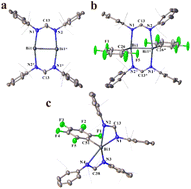
Dalton Trans., 2023,52, 6619-6623
https://doi.org/10.1039/D3DT00534H
Probing B–X to B–H conversions and applications in C–F bond activation catalysis
The conversion of B–X to B–H bonds in the presence of silane is probed. 9-X-9-borabicyclo[3.3.1]nonane (B–F-9-BBN, = F) is shown to react directly with silane. Thus 9-BBN in the presence of silane catalyzes benzylation of arenes with benzyl fluorides.

Dalton Trans., 2022,51, 17962-17966
https://doi.org/10.1039/D2DT03588J
Fluorinated tris(pyridyl)borate ligand support on coinage metals
Chemically robust, tris(pyridyl)borate with a fluorine-lined coordination pocket allows the stabilization and detailed investigation of organometallic complexes of group 11 metal ions involving a small gaseous molecule, ethylene.
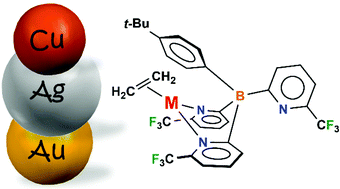
Dalton Trans., 2022,51, 1308-1312
https://doi.org/10.1039/D1DT04136C
From ferrocene to 1,2,3,4,5-pentafluoroferrocene: halogen effect on the properties of metallocene
Impact of successive fluorinations onto redox, spectroscopic and NMR properties of ferrocene.
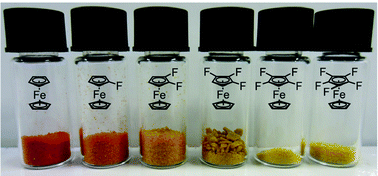
Dalton Trans., 2021,50, 16933-16938
https://doi.org/10.1039/D1DT03430H
C–H and C–F coordination of arenes in neutral alkaline earth metal complexes
A series of neutral magnesium and calcium complexes that display various novel group 2⋯arene interaction have been synthesised and structurally characterised.

Dalton Trans., 2021,50, 8685-8689
https://doi.org/10.1039/D1DT01532J
Isolation and structural characterisation of rhodium(III) η2-fluoroarene complexes: experimental verification of predicted regioselectivity
Well defined rhodium complexes for probing the coordination site preference of partially fluorinated benzenes.
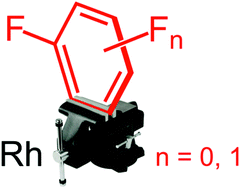
Dalton Trans., 2020,49, 5791-5793
https://doi.org/10.1039/D0DT01137A
Direct conversion of uranium dioxide UO2 to uranium tetrafluoride UF4 using the fluorinated ionic liquid [Bmim][PF6]
[Bmim][PF6] ionic liquid is used for the direct conversion of uranium dioxide UO2 to uranium tetrafluoride UF4.
![Graphical abstract: Direct conversion of uranium dioxide UO2 to uranium tetrafluoride UF4 using the fluorinated ionic liquid [Bmim][PF6]](/en/Image/Get?imageInfo.ImageType=GA&imageInfo.ImageIdentifier.ManuscriptID=C9DT04327F&imageInfo.ImageIdentifier.Year=2020)
Dalton Trans., 2020,49, 274-278
https://doi.org/10.1039/C9DT04327F
Coinage metal-ethylene complexes of sterically demanding 1,10-phenanthroline ligands
Bulky phenanthroline provides ideal support to stabilize ethylene complexes of copper(I), silver(I) and gold(I), permitting their complete characterization. Copper complexes catalyze the carbene insertion to C–H bonds of adamantane.
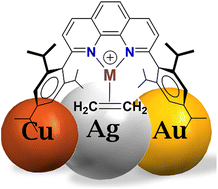
Dalton Trans., 2024,53, 10426-10433
https://doi.org/10.1039/D4DT00822G
Interplay between coordination sphere engineering and properties of nickel diketonate–diamine complexes as vapor phase precursors for the growth of NiO thin films
Coordination sphere engineering of nickel diketonate–diamine adducts enables tailoring of precursor properties of relevance for the vapor phase deposition of pure NiO films.

Dalton Trans., 2023,52, 10677-10688
https://doi.org/10.1039/D3DT01282D
Anionic N-heterocyclic carbenes featuring weakly coordinating perfluoroalkylphosphorane moieties
Novel anionic N-heterocyclic carbenes featuring weakly coordinating (C2F5)3PF2− groups at imidazoline were synthesized. These WCA-NHCs are promising ligands with enhanced donor and acceptor properties compared to neutral NHCs.

Dalton Trans., 2023,52, 9553-9561
https://doi.org/10.1039/D3DT01249B
Fluorinated linkers enable the synthesis of flexible MOFs with 1D alkaline earth SBUs and a temperature-induced phase transition
The use of fluorinated BTB leads to the formation of UoC-9 with an unprecedented framework topology, crystalline sponge behaviour and a low-temperature phase transition. Hirshfeld analysis reveals the underlying host–guest interactions in this MOF.

Dalton Trans., 2023,52, 5926-5934
https://doi.org/10.1039/D3DT00422H
An investigation into the Brønsted acidity of the perfluorinated alkoxy silanes {(F3C)3CO}3SiH and {(F6C5)3CO}2Si(Cl)H
The Si–H bond in {(F3C)3CO}3SiH is exceptionally strong and short; yet the acidity is comparable to common organic acids. This apparent contradiction will be discussed with the aid of contemporary DFT methods.

Dalton Trans., 2023,52, 5918-5925
https://doi.org/10.1039/D3DT00299C
Substitution lability of the perfluorinated Cp* ligand in Rh(I) complexes
Fluorinated pyridines can displace the anionic [C5(CF3)5]− ligand in [Rh(COD)(C5(CF3)5)], however the reaction is reversible in weakly coordinating solvents as CHCl3.
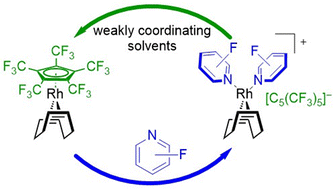
Dalton Trans., 2023,52, 5496-5502
https://doi.org/10.1039/D3DT00425B
Synthesis of imidazolium-based pentacoordinated organofluorosilicate and germanate salts
Naked fluoride reagent [IPrH][F] was used to prepare and structurally characterise a rare organofluorogermanate compound [IPrH][Ph3GeF2] and other organofluorosilicate species.

Dalton Trans., 2023,52, 5085-5094
https://doi.org/10.1039/D3DT00421J
Phenylimido complexes of rhenium: fluorine substituents provide protection, reactivity, and solubility
The electronic properties and steric bulk of isocyanides are modulated by partial fluorination of the ligands. The fluorination of phenylimides provides solubility.

Dalton Trans., 2023,52, 4768-4778
https://doi.org/10.1039/D3DT00446E
The perfluoroadamantoxy aluminate as an ideal weakly coordinating anion? – synthesis and first applications
Dream WCA…? The very high fluoride ion affinity of the Lewis acid underlying the novel WCA [Al(OC10F15)4]− ([pfAd]−) nurtures the hope for having found a new “dream WCA”. Yet, the paths towards this WCA held some obstacles at hand...!

Dalton Trans., 2023,52, 4355-4370
https://doi.org/10.1039/D3DT00199G
Relativistic modulation of supramolecular halogen/copper interactions and phosphorescence in Cu(I) pyrazolate cyclotrimers
Cu3[4-I-3,5-(CF3)2Pz]3 exhibits stronger supramolecular Cu3⋯halogen interactions vs. its 4-Br/4-Cl analogues, double- vs. single-capped; this relativistic enhancement yet results in quenched phosphorescence.

Dalton Trans., 2023,52, 3964-3970
https://doi.org/10.1039/D2DT03725D
Synthesis and lewis acidity of fluorinated triaryl borates
A series of fluorinated triaryl borates B(OArF)3 (ArF = 2-FC6H4, 3-FC6H4, 4-FC6H4, 2,4-F2C6H3, 3,5-F2C6H3, 2,3,4-F3C6H2, 2,4,6-F3C6H2, 3,4,5-F3C6H2) have been prepared and isolated from the reactions of the mono-, di-, or tri-fluorophenol with BCl3.
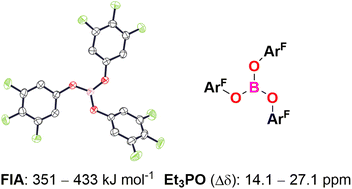
Dalton Trans., 2023,52, 1820-1825
https://doi.org/10.1039/D2DT04095F
Iridium complexes of an ortho-trifluoromethylphenyl substituted PONOP pincer ligand
Novel coordination chemistry of iridium(I) and iridium(III) using a trifluoromethyl-functionalised PONOP pincer ligand.

Dalton Trans., 2023,52, 1096-1104
https://doi.org/10.1039/D2DT03608H
Reactivity of bi- and monometallic trifluoroacetates towards amorphous SiO2
The reactivity of alkali–manganese(II) and alkali trifluoroacetates towards amorphous SiO2 was studied in the solid-state with an eye towards the synthesis of alkali fluorosilicates.

Dalton Trans., 2022,51, 18224-18233
https://doi.org/10.1039/D2DT02822K
Fluorinated click-derived tripodal ligands drive spin crossover in both iron(II) and cobalt(II) complexes
A fluorophenyl-substituted ligand drives complete and partial spin-crossover in Fe(II) and Co(II) complexes, respectively.

Dalton Trans., 2022,51, 10507-10517
https://doi.org/10.1039/D2DT01005D
Synthesis, structure, and electrochemical properties of [LNi(Rf)(C4F8)]− and [LNi(Rf)3]− complexes
The new anionic nickelate complexes [(MeCN)Ni(C4F8)(CF3)]−, [(MeCN)Ni(C4F8)(C2F5)]−, [(IMes)Ni(C4F8)(CF3)]−, [(IMes)Ni(CF3)3]− and [(F-NHC)Ni(Rf)3]− (F-NHC = fluorinated NHC) were synthesized and fully characterized.
![Graphical abstract: Synthesis, structure, and electrochemical properties of [LNi(Rf)(C4F8)]− and [LNi(Rf)3]− complexes](/en/Image/Get?imageInfo.ImageType=GA&imageInfo.ImageIdentifier.ManuscriptID=D2DT00511E&imageInfo.ImageIdentifier.Year=2022)
Dalton Trans., 2022,51, 5515-5523
https://doi.org/10.1039/D2DT00511E
Oxidation of europium with ammonium perfluorocarboxylates in liquid ammonia: pathways to europium(II) carboxylates and hexanuclear europium(III) fluoridocarboxylate complexes
This work introduces the first europium(II) perfluorocarboxylate and the use of its class of compounds in the facile synthesis of octahedro-hexanuclear europium(III) fluoridocarboxylates with interesting luminophoric properties.

Dalton Trans., 2022,51, 4814-4828
https://doi.org/10.1039/D1DT04204A
Lewis acid–base adducts of Al(N(C6F5)2)3 and Ga(N(C6F5)2)3 – structural features and dissociation enthalpies
Herein we present the molecular structures of six neutral Lewis acid–base adducts of the Lewis superacid Al(N(C6F5)2)3 and its higher homolog Ga(N(C6F5)2)3 with the electron pair donors MeCN, CNtBu, THF and PMe3.
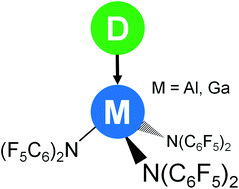
Dalton Trans., 2022,51, 4829-4835
https://doi.org/10.1039/D2DT00003B
Synthesis, structural and photophysical properties of dimethylphosphino(perfluoro-)phenylene-based gold(I) dimers
Driven by different weak non-covalent interactions [Au2(μ2-C6H4PMe2)2] and its aryl-perfluorinated analogue aggregate vastly differently in the solid state: the non-fluorinated prefers aurophilic interactions, the fluorinated aryl–aryl interactions.
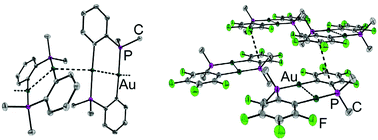
Dalton Trans., 2022,51, 1955-1967
https://doi.org/10.1039/D1DT03658K
Spin-state control of cobalt(II) and iron(II) complexes with click-derived tripodal ligands through non-covalent and fluorine-specific interactions
Fluorine-specific interactions in the secondary coordination sphere of iron(II) and cobalt(II) complexes with click-derived fluorinated tripodal ligands are shown to control the spin states of the metal centers.

Dalton Trans., 2021,50, 18097-18106
https://doi.org/10.1039/D1DT03535E
Facile preparation of a cobalt diamine diketonate adduct as a potential vapor phase precursor for Co3O4films
A novel heteroleptic Co(II) complex has been synthesized, characterized and successfully evaluated as a precursor for the CVD of Co3O4 thin films with tailored properties.
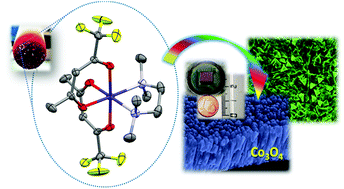
Dalton Trans., 2021,50, 10374-10385
https://doi.org/10.1039/D1DT01650D
High magnetization reversal barriers in luminescent dysprosium octahedral and pentagonal bipyramidal single-molecule magnets based on fluorinated alkoxide ligands
Three luminescent single-molecules magnets based on different fluorinated alkoxide ligands and exhibiting high magnetization reversal barriers are reported.
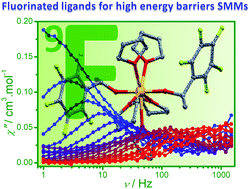
Dalton Trans., 2021,50, 8487-8496
https://doi.org/10.1039/D1DT01319J
Investigation of the biological and photophysicochemical properties of new non-peripheral fluorinated phthalocyanines
The photophysicochemical and biological properties of new fluorinated phthalocyanines were examined. The synergistic effect of phthalocyanines used as colorants in ink formulas with other chemicals available was investigated for the first time.
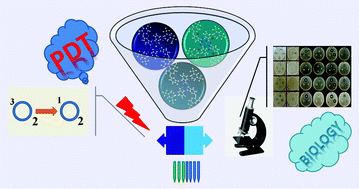
Dalton Trans., 2021,50, 2736-2745
https://doi.org/10.1039/D0DT04351F
Alkaline-earth complexes with macrocyclic-functionalised bis(phenolate)s and bis(fluoroalkoxide)s
The syntheses and structural features of several families of well-defined complexes of the large alkaline earths (calcium, strontium and barium) bearing dianionic, multidentate bis(phenolato) or bis(fluoroalkoxo) ligands are presented.

Dalton Trans., 2020,49, 13017-13028
https://doi.org/10.1039/D0DT02573A
Electronic effect of a perfluorinated β-diketiminate ligand on the bonding nature of copper carbonyl complexes
A combined experimental and computational study demonstrates the influence of fluorine substituents on the electronic properties of β-diketiminate ligands.
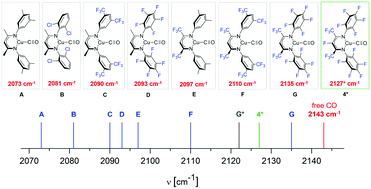
Dalton Trans., 2020,49, 9773-9780
https://doi.org/10.1039/D0DT01943G
Using frustrated Lewis pairs to explore C–F bond activation
Our interest in C–F bond activation prompted an investigation of the reactions of PhC(O)CF3 with a superbasic proazaphosphatrane (Verkade's base) and a corresponding FLP.
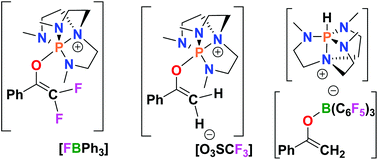
Dalton Trans., 2020,49, 1319-1324
https://doi.org/10.1039/C9DT04588K
C–H and C–F bond activation reactions of pentafluorostyrene at rhodium complexes
Reactions of various Rh(I) complexes towards penta-fluorostyrene or its borylated derivative afforded coordination and C–F bond or C–H bond activation reactions.
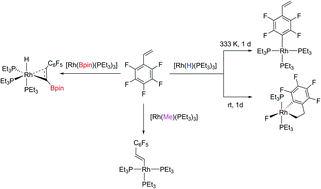
Dalton Trans., 2019,48, 16258-16267
https://doi.org/10.1039/C9DT03371H
Acetylene and terminal alkyne complexes of copper(I) supported by fluorinated pyrazolates: syntheses, structures, and transformations
A variety of isolable, 2 : 1 and 1 : 1 copper(I)–alkyne complexes of containing pyrazolate ligand supports are presented as well as the copper pyrazolate mediated acetylenic C–H and alkyne C![[triple bond, length as m-dash]](https://www.rsc.org/images/entities/char_e002.gif) C bond functionalizations.
C bond functionalizations.
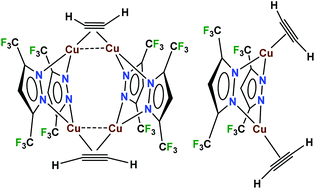
Dalton Trans., 2019,48, 15782-15794
https://doi.org/10.1039/C9DT03350E
Highly fluorinated metal complexes as dual 19F and PARACEST imaging agents
Highly fluorinated, water-soluble transition metal complexes serve as both 19F and PARACEST magnetic resonance imaging agents.
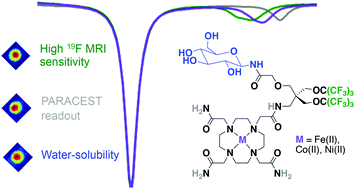
Dalton Trans., 2019,48, 9337-9341
https://doi.org/10.1039/C9DT01852B
About this collection
Fluorinated ligands and their effects on physical properties and chemical reactivity
Fluorine embodies reactivity and inertness, both of which are exploited by inorganic chemists. It is the most electronegative element in the periodic table (3.98 on the Pauling scale) and has a remarkably high reduction potential (2.87 V). The van der Waals and covalent radii of fluorine are quite short (ranked third, only after the first-row elements hydrogen and helium), making it unusually small for its atomic number. The homonuclear bond in F2 is particularly reactive while some heteronuclear bonds involving fluorine are remarkably stable. The combined effects of these features on fluorine-containing molecules are often unmatched by any other element, for example with carbon, where it forms very robust, chemically inert single bonds; the BDE of C-F compared to C-H bonds in CF4 and CH4 are 546.8 and 439.3 kJ/mol, respectively.
Metal complexes of fluorinated ligands in comparison to their non-fluorinated, hydrocarbon counterparts, usually display different properties such as relatively high thermal and oxidative stability, volatility, diminished vibrational modes and shifted spectroscopic features (absorption and emission), as well as unique reactivity profiles. They are also ideal for applications in fluorous-biphase media and supercritical CO2. Additionally, fluorine containing anions such as [BF4]-, [SbF6]-, [B(C6F5)4]−, and [B{3,5-(CF3)2C6H3}4]− are among the weakest donors known. This Spotlight collection brings together contributions by leading researchers on this topic to highlight some of the fascinating developments in fluorinated supporting ligands, C-F inertness, electron-withdrawing effects of fluoro-substituents, the weakly-coordinating nature of fluorinated anions, efforts to functionalize C-F bonds, and species that selectively deliver F, F· and F-.
This collection is guest edited by Dalton Transactions Advisory Board member Professor Rasika Dias, The University of Texas at Arlington, USA, and Professor Linda Doerrer, Boston University, USA.
Articles will be added to this themed collection as soon as possible after they are published. Please return to this page frequently to see the collection grow.
If you would like to contribute an article to this collection, please contact the Editorial Office at dalton-rsc@rsc.org with your proposed topic.